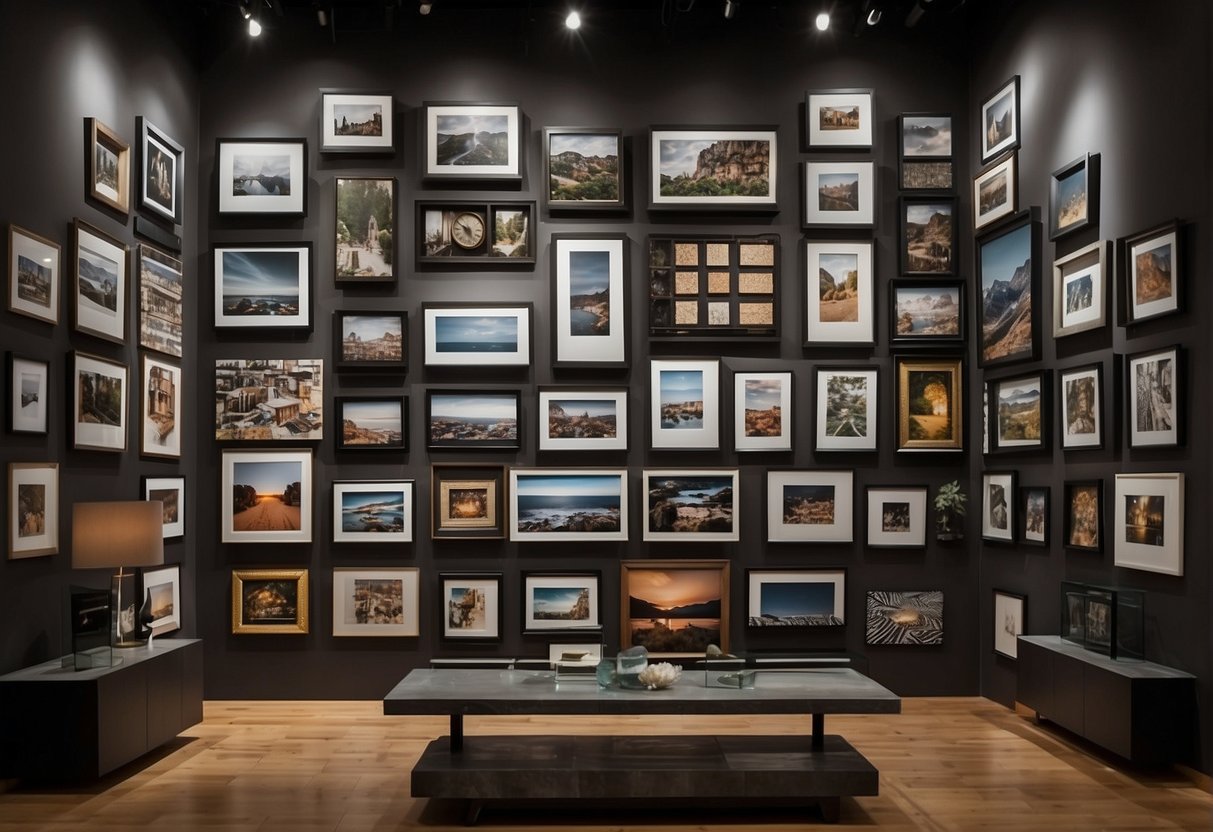
How Regular Rotation of Artwork Boosts Client Satisfaction and Drives Sales Opportunities
Art galleries and collectors have long recognized the importance of rotating their artwork, both for the benefit of their clients and creating ongoing sales opportunities. The regular rotation of artwork not only keeps the space fresh and engaging but also ensures that artwork remains visible, increasing the likelihood of it finding a forever home. Artists, collectors, and gallery owners can all benefit from adopting this effective strategy.

Regular art rotation has numerous advantages, including allowing clients to discover new pieces, engaging with the work in new ways, and allowing the artist's growth and creativity to become more evident. Additionally, strategically rotating the works can pique interest, spark conversations, and ultimately encourage sales. This practice also extends to interior designers, corporate collectors, and even enthusiastic home collectors, who can create a dynamic and ever-changing environment for their clientele or personal enjoyment.
Managing the rotation of artwork in a gallery or collection requires organization, communication, and strategy. Key factors to consider include determining which pieces should be rotated, finding the optimal time to make the switch, and understanding the aesthetic preferences of clients and potential buyers. Through careful planning and diligent execution, galleries and collectors will maximize the potential of their investment, while artists will gain increased exposure and opportunities for revenue.
Key Takeaways
- Rotating artwork allows clients to discover and engage with new pieces, boosting exposure and sales.
- This practice benefits galleries, collectors, artists, and interior designers alike.
- Successful art rotation requires strategic planning and communication to maximize potential revenue.
Benefits of Regular Art Rotation

Keeping Interests High and Fresh
An important factor to consider in any business is maintaining the interest of your clients. Regularly rotating artwork is an effective way to keep their attention and provide fresh perspectives. This also helps to showcase an ever-changing selection of pieces, therefore giving clients an opportunity to discover and fall in love with new works. It also allows for the presentation of various styles, themes, and mediums, catering to diverse tastes and preferences. Consequently, a well-curated art collection can pique the curiosity of clients and encourage repeat sales.
- Bold moves: Showcasing new and exciting pieces keeps client interest high.
- Diverse selection: Offering various styles and themes appeals to a wider audience.
- Frequent updates: Rotating art collections help to create an air of freshness.
Enhancing Aesthetic and Work Environment
A stimulating and engaging work environment has been proven to boost productivity and improve overall well-being. By regularly rotating artwork, clients can transform their space without resorting to costly renovation projects. This dynamic decor helps maintain a fresh and inspiring atmosphere, promoting creativity, positivity, and increased satisfaction within their environment. Moreover, a thoughtfully-curated art collection can elevate the client's brand and impress their audience.
- Boosted productivity: An interesting visual setting inspires creativity and motivation.
- Brand enhancement: High-quality and well-curated artwork reflects positively on the client's image.
- Improved well-being: Artistic surroundings foster a sense of enjoyment and satisfaction.
Building and Maintaining Relationships
Relationship building is a significant aspect of a successful art gallery or artist-client partnership. Establishing a personal connection increases the chances of repeat sales, as clients are more likely to return when they feel understood and valued. By assisting them in rotating their art collection, you demonstrate that you appreciate their tastes and preferences, and actively participate in meeting their needs. Additionally, maintaining this connection grants you the opportunity to introduce the client to new artists and pieces, further broadening their artistic horizons.
- Personal touch: Establishing a connection strengthens brand loyalty and fosters long-term relationships.
- Tailored experience: Understanding and appreciating client preferences encourages repeat sales.
- Expanding tastes: Introducing clients to new artists and works broadens their art appreciation.
Sales Opportunities Through Rotation

Continuous Exposure and Marketing
Regular rotation of artwork benefits clients by providing continuous exposure and marketing opportunities. By constantly changing the selection on display, galleries and artists can showcase a wider range of pieces, ensuring that each visit feels fresh and new. This approach keeps clients engaged and increases the likelihood of future purchases. Galleries can utilize various marketing tools such as social media, email newsletters, and targeted ads to promote new rotations and highlight featured pieces.
Additionally, artwork rotations can facilitate collaborations with other galleries or artists through joint exhibitions, expanding networking opportunities and attracting a more diverse audience. Including a mix of emerging and established artists in the rotation can also create buzz and draw potential buyers.
Targeted Promotions and Offers
Artwork rotations provide an opportunity for targeted promotions and offers aimed at a specific target audience. Galleries can create special events, discounts, or exclusive previews for loyal clients and collectors, incentivizing them to return and make additional purchases. These promotions are more effective when tailored to the interests of individual clients, which can be achieved through customer relationship management (CRM) tools.
Furthermore, offering a flexible shipping policy for artwork can be an appealing factor for clients, giving them the convenience of buying art from various locations and having it safely delivered to their homes.
Engaging with a Broader Audience
Rotating artwork regularly allows galleries and artists to engage with a broader audience, both online and offline. An updated online presence, such as an e-commerce platform or virtual exhibitions, can make it easier for clients to view and purchase artwork. Galleries can use social media and other online marketing strategies to share images of the latest rotations, driving online traffic and sales.
Offline, hosting events, such as exclusive previews and artist talks, can attract new clients who might not have been aware of the gallery or its artists. By using a diversified marketing strategy, galleries can reach a wider audience, ultimately leading to more sales opportunities.
In summary, regular rotation of artwork can create continuous exposure, targeted promotions, and opportunities to engage with a broader audience, all of which benefit clients and contribute to ongoing sales.
Artwork Management Strategies for Galleries
Cataloging and Curation Practices
Effective artwork management begins with thorough cataloging and curation practices. Galleries need to maintain a well-organized database of their inventory, including information on each piece such as title, artist, medium, size, and provenance. This allows for easy tracking and management of the artwork, as well as providing clients with accurate and detailed information.
One essential task for a curator is to carefully select and display different artwork that appeals to diverse client bases. It may involve highlighting emerging artists, featuring established names, or creating thematic exhibitions. Curators should also be mindful of the pricing strategies, choosing works with a range of prices to facilitate ongoing sales opportunities for various budget levels.
Effective Use of Space and Lighting
Galleries must take advantage of their available space to effectively display the artwork. This can involve arranging pieces in a visually engaging manner and using the gallery layout to guide clients through the exhibit. Providing a comfortable and uncluttered environment can encourage clients to spend more time browsing the artwork, increasing the likelihood of sales.
Lighting is a crucial aspect of gallery presentation. Proper use of lighting can enhance the artwork, bring attention to key pieces, and create a more inviting atmosphere for clients. Galleries should be aware of any specific lighting needs for certain pieces (e.g., avoiding direct sunlight for sensitive materials) to ensure optimal display conditions and proper maintenance.
Leveraging Online Platforms
In today's digital age, an online presence is essential for art business success. A user-friendly, visually appealing website can showcase the gallery's inventory and provide useful information on artists, upcoming exhibitions, and gallery representation. Additionally, having an e-commerce platform on the website enables clients to easily purchase artwork, opening up sales opportunities beyond physical gallery visits.
Galleries can also leverage social media platforms to engage with clients, promote artists, and announce new arrivals. By using these tools effectively, galleries can reach a wider audience and foster relationships with potential buyers.
To facilitate a smooth and pleasant purchasing experience, galleries should have efficient systems in place for delivery and installation of artwork. Providing white-glove services can set a gallery apart and ensure that clients will return for future transactions.
Implementing these artwork management strategies enables galleries to provide a dynamic and engaging experience for clients while creating ongoing sales opportunities.
Frequently Asked Questions
What are the advantages of rotating art displays in corporate environments?
Rotating art displays in corporate environments brings a range of advantages: it refreshes the visual environment, supports local artists, and showcases the company's commitment to creativity and innovation. Regularly changing artwork also stimulates employees' minds, fostering a more dynamic and inspiring atmosphere.
How does changing artwork enhance the aesthetic appeal of a business space?
Changing artwork enhances the aesthetic appeal of a business space by keeping the visual elements fresh and engaging. It helps avoid the monotony of having the same artworks displayed over a long period of time and contributes to creating an inspiring environment that fosters creativity and innovation.
In what ways does artwork rotation in the workplace impact employee productivity and creativity?
Artwork rotation in the workplace can positively impact employee productivity and creativity by providing ongoing visual stimulation. Surrounding employees with new and different art pieces can inspire new ideas, encourage innovative thinking, and help employees feel more connected to their work environment.
Can frequent changes in displayed artwork influence client perceptions and business reputation?
Yes, frequent changes in displayed artwork can influence client perceptions and business reputation by demonstrating a company's commitment to creativity, innovation, and support for local talent. Showcasing a diverse range of artworks sends a message that the company values aesthetics and is invested in creating an impressive and comfortable space for its clients.
How can artists and galleries establish repeat sales through art rotation programs?
Artists and galleries can establish repeat sales through art rotation programs by offering flexible and customizable options for businesses. These may include special pricing for long-term rotations, showcasing new and exclusive art pieces, or offering consultation services to select the most appropriate artwork for a given space and brand identity. By providing these services, artists and galleries can build strong relationships with their clients, leading to ongoing sales opportunities.
What strategic approaches can art consultants recommend for businesses to leverage art as a tool for brand storytelling?
Art consultants can recommend a variety of strategic approaches to help businesses leverage art as a tool for brand storytelling. These may include selecting artworks that align with the company's values and mission, commissioning custom pieces that reflect the business and its culture, or incorporating interactive installations that engage both employees and clients. By prioritizing art that complements the company's story, businesses can create a cohesive and captivating environment that communicates their identity to all who visit.